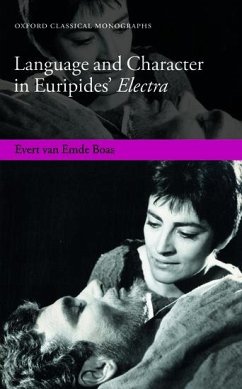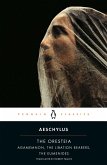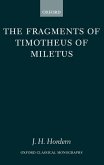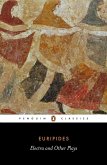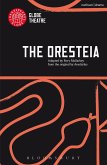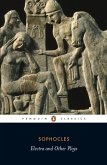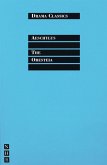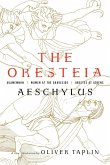Evert Van Emde Boas
Language and Character in Euripides' Electra
Evert Van Emde Boas
Language and Character in Euripides' Electra
- Gebundenes Buch
- Merkliste
- Auf die Merkliste
- Bewerten Bewerten
- Teilen
- Produkt teilen
- Produkterinnerung
- Produkterinnerung
This study of Euripides' Electra marries linguistics and literary criticism to provide novel insights into the interpretation of the play. Focusing on characterization, it demonstrates how the figures are shaped through their use of language, using new means of analysis to argue for a balanced interpretation and challenge prevailing views.
Andere Kunden interessierten sich auch für
![The Oresteia The Oresteia]() AeschylusThe Oresteia15,99 €
AeschylusThe Oresteia15,99 €![The Fragments of Timotheus of Miletus The Fragments of Timotheus of Miletus]() James H. Hordern (, Research Fellow in the Department of Classics,The Fragments of Timotheus of Miletus263,99 €
James H. Hordern (, Research Fellow in the Department of Classics,The Fragments of Timotheus of Miletus263,99 €![Electra and Other Plays: Euripides Electra and Other Plays: Euripides]() EuripidesElectra and Other Plays: Euripides13,99 €
EuripidesElectra and Other Plays: Euripides13,99 €![The Oresteia The Oresteia]() AeschylusThe Oresteia18,99 €
AeschylusThe Oresteia18,99 €![Electra and Other Plays Electra and Other Plays]() SophoclesElectra and Other Plays15,99 €
SophoclesElectra and Other Plays15,99 €![The Oresteia The Oresteia]() AeschylusThe Oresteia13,99 €
AeschylusThe Oresteia13,99 €![The Oresteia The Oresteia]() AeschylusThe Oresteia23,99 €
AeschylusThe Oresteia23,99 €-
-
-
This study of Euripides' Electra marries linguistics and literary criticism to provide novel insights into the interpretation of the play. Focusing on characterization, it demonstrates how the figures are shaped through their use of language, using new means of analysis to argue for a balanced interpretation and challenge prevailing views.
Hinweis: Dieser Artikel kann nur an eine deutsche Lieferadresse ausgeliefert werden.
Hinweis: Dieser Artikel kann nur an eine deutsche Lieferadresse ausgeliefert werden.
Produktdetails
- Produktdetails
- Oxford Classical Monographs
- Verlag: Oxford University Press
- Seitenzahl: 336
- Erscheinungstermin: 19. März 2017
- Englisch
- Abmessung: 218mm x 140mm x 25mm
- Gewicht: 504g
- ISBN-13: 9780198793601
- ISBN-10: 019879360X
- Artikelnr.: 47866588
- Herstellerkennzeichnung
- Libri GmbH
- Europaallee 1
- 36244 Bad Hersfeld
- gpsr@libri.de
- Oxford Classical Monographs
- Verlag: Oxford University Press
- Seitenzahl: 336
- Erscheinungstermin: 19. März 2017
- Englisch
- Abmessung: 218mm x 140mm x 25mm
- Gewicht: 504g
- ISBN-13: 9780198793601
- ISBN-10: 019879360X
- Artikelnr.: 47866588
- Herstellerkennzeichnung
- Libri GmbH
- Europaallee 1
- 36244 Bad Hersfeld
- gpsr@libri.de
Evert van Emde Boas is a Postdoctoral Research Associate at the Calleva Research Centre at Magdalen College, Oxford, where his work forms part of an interdisciplinary investigation of the psychology of theatre audiences. He received his BA and MA degrees from the University of Amsterdam and completed both an MSt and a DPhil at the University of Oxford, before going on to hold various teaching and research positions at the University of Amsterdam, VU University Amsterdam, the University of Groningen, and Leiden University. His research focuses primarily on the application of modern linguistic and cognitive approaches to ancient Greek literature.
Frontmatter
List of Figures
A Note on Citation, Abbreviations, and Cross-referencing
0: Introduction: Modern Linguistics and Euripides' Electra
1. Aims, approaches, outline
1.1. Reading, linguistically
1.2. Outline of the book
2. Linguistic approaches
2.1. Introduction: Bauformen and text types
2.2. Conversation Analysis
2.3. Pragmatics
2.3.1 Speech acts
2.3.2 (Neo-)Gricean theories of meaning
2.4. Sociolinguistics
2.4.1 Gender
2.4.2 Politeness and power
2.5. Gnomic utterances in context: some aspects of modern paremiology
2.6. Narrative and argumentative texts: discourse cohesion
3. Textual criticism
4. A view of the play
4.1. Characters and characterization
4.1.1 Conceptualization; characterization through style
4.1.2 Electra and Orestes
4.2. Themes and motifs
4.3. Tradition (and the recognition scene)
4.4. The roads not taken . . .
I: Rustic Language: The Peasant
1. Introduction
2. A peasant's tale (1 53)
3. Husband and wife (54 81, 341 63, 404 31)
3.1. A marriage under face-threat
3.2. Getting water (54 81)
3.3. Welcoming guests (341 63)
3.4. Preparing food (404 31)
4. Further stylistic points; conclusion
II: Constancy Amid Change: The Linguistic Characterization of Electra
1. Introduction
2. Resistance through lament: the early scenes (54 81, 112 214)
2.1. Electra as mourner
2.2. Electra as wife
2.3. Electra as Argive 'maiden'
2.4. The characterization of Electra
2.4.1 Patterns of miscommunication
2.4.2 Electra's character: the debate
3. Electra and her unexpected guest (215 338)
3.1. The stichomythia (215 89)
3.2. The 'message' (300 38)
4. Recognition and planning (487 698)
5. Electra, Aegisthus, and Clytemnestra
5.1. A play of halves?
5.2. The 'kakology' (907 56)
5.2.1 Electra's 'undramatic' generalizations
5.2.2 Analysis of the speech
5.3. 'Into the boudoir': Electra and Clytemnestra (998 1146)
5.3.1 Opening exchanges (998 1010)
5.3.2 Clytemnestra's speech (1011 50)
5.3.3 Parrhesia (1055 9)
5.3.4 Electra's speech (1060 99)
5.3.5 Mother and daughter (1102 46)
6. Exodos
6.1. The kommos (1177 1232)
6.2. The deus ex machina (1233 1358)
III: Orestes' Linguistic (Dis)guises
1. Introduction
2. Orestes incognito
2.1. Initial observations
2.2. The general reflections
2.2.1 'A man in exile is powerless' (236)
2.2.2 Pity and intelligence (290 6)
2.2.3 Evaluating character (367 400)
2.3. The second disguise (774 858)
3. Conclusion
IV: Redrawing the Lines: Pragmatics and Gender in Textual Criticism
1. Introduction
1.1. Vexed passages
1.2. L and P
2. Divided (?) we pray (671 84)
3. The hesitation scene (959 87)
3.1. On giving orders and having fashion sense (959 66)
3.2. Diverging minds (967 87)
4. Conclusion
V: A Tense Affair: The Messenger Speech
1. Introduction
2. Not 'what?' but 'how?'
3. Analysis of the narrative
3.1. Setting the scene (774 8)
3.2. 'A deliciously protracted game of cat and mouse' (779 97)
3.3. A moment for prayer (798 810)
3.4. The sacrifice of Aegisthus (810 43)
3.5. Aftermath and resolution (844 55, 855 7, 857 8)
3.6. Evaluation
4. Conclusion
VI: The Language of Rhetoric: The Agon Revisited
1. Introduction
2. Exordium
2.1. Clytemnestra
2.2. Electra
3. Narratio
3.1. Clytemnestra
3.2. Electra
4. Argumentatio
4.1. Generalizations
4.2. Clytemnestra's hypotheticals
4.3. Rhetoric and characterization
5. Peroratio
5.1. Clytemnestra
5.2. Electra
6. Peroratio (II)
VII: Conclusion: Approaching Tragic Language
Endmatter
Glossary of Linguistic Terms
Bibliography
Indexes
List of Figures
A Note on Citation, Abbreviations, and Cross-referencing
0: Introduction: Modern Linguistics and Euripides' Electra
1. Aims, approaches, outline
1.1. Reading, linguistically
1.2. Outline of the book
2. Linguistic approaches
2.1. Introduction: Bauformen and text types
2.2. Conversation Analysis
2.3. Pragmatics
2.3.1 Speech acts
2.3.2 (Neo-)Gricean theories of meaning
2.4. Sociolinguistics
2.4.1 Gender
2.4.2 Politeness and power
2.5. Gnomic utterances in context: some aspects of modern paremiology
2.6. Narrative and argumentative texts: discourse cohesion
3. Textual criticism
4. A view of the play
4.1. Characters and characterization
4.1.1 Conceptualization; characterization through style
4.1.2 Electra and Orestes
4.2. Themes and motifs
4.3. Tradition (and the recognition scene)
4.4. The roads not taken . . .
I: Rustic Language: The Peasant
1. Introduction
2. A peasant's tale (1 53)
3. Husband and wife (54 81, 341 63, 404 31)
3.1. A marriage under face-threat
3.2. Getting water (54 81)
3.3. Welcoming guests (341 63)
3.4. Preparing food (404 31)
4. Further stylistic points; conclusion
II: Constancy Amid Change: The Linguistic Characterization of Electra
1. Introduction
2. Resistance through lament: the early scenes (54 81, 112 214)
2.1. Electra as mourner
2.2. Electra as wife
2.3. Electra as Argive 'maiden'
2.4. The characterization of Electra
2.4.1 Patterns of miscommunication
2.4.2 Electra's character: the debate
3. Electra and her unexpected guest (215 338)
3.1. The stichomythia (215 89)
3.2. The 'message' (300 38)
4. Recognition and planning (487 698)
5. Electra, Aegisthus, and Clytemnestra
5.1. A play of halves?
5.2. The 'kakology' (907 56)
5.2.1 Electra's 'undramatic' generalizations
5.2.2 Analysis of the speech
5.3. 'Into the boudoir': Electra and Clytemnestra (998 1146)
5.3.1 Opening exchanges (998 1010)
5.3.2 Clytemnestra's speech (1011 50)
5.3.3 Parrhesia (1055 9)
5.3.4 Electra's speech (1060 99)
5.3.5 Mother and daughter (1102 46)
6. Exodos
6.1. The kommos (1177 1232)
6.2. The deus ex machina (1233 1358)
III: Orestes' Linguistic (Dis)guises
1. Introduction
2. Orestes incognito
2.1. Initial observations
2.2. The general reflections
2.2.1 'A man in exile is powerless' (236)
2.2.2 Pity and intelligence (290 6)
2.2.3 Evaluating character (367 400)
2.3. The second disguise (774 858)
3. Conclusion
IV: Redrawing the Lines: Pragmatics and Gender in Textual Criticism
1. Introduction
1.1. Vexed passages
1.2. L and P
2. Divided (?) we pray (671 84)
3. The hesitation scene (959 87)
3.1. On giving orders and having fashion sense (959 66)
3.2. Diverging minds (967 87)
4. Conclusion
V: A Tense Affair: The Messenger Speech
1. Introduction
2. Not 'what?' but 'how?'
3. Analysis of the narrative
3.1. Setting the scene (774 8)
3.2. 'A deliciously protracted game of cat and mouse' (779 97)
3.3. A moment for prayer (798 810)
3.4. The sacrifice of Aegisthus (810 43)
3.5. Aftermath and resolution (844 55, 855 7, 857 8)
3.6. Evaluation
4. Conclusion
VI: The Language of Rhetoric: The Agon Revisited
1. Introduction
2. Exordium
2.1. Clytemnestra
2.2. Electra
3. Narratio
3.1. Clytemnestra
3.2. Electra
4. Argumentatio
4.1. Generalizations
4.2. Clytemnestra's hypotheticals
4.3. Rhetoric and characterization
5. Peroratio
5.1. Clytemnestra
5.2. Electra
6. Peroratio (II)
VII: Conclusion: Approaching Tragic Language
Endmatter
Glossary of Linguistic Terms
Bibliography
Indexes
Frontmatter
List of Figures
A Note on Citation, Abbreviations, and Cross-referencing
0: Introduction: Modern Linguistics and Euripides' Electra
1. Aims, approaches, outline
1.1. Reading, linguistically
1.2. Outline of the book
2. Linguistic approaches
2.1. Introduction: Bauformen and text types
2.2. Conversation Analysis
2.3. Pragmatics
2.3.1 Speech acts
2.3.2 (Neo-)Gricean theories of meaning
2.4. Sociolinguistics
2.4.1 Gender
2.4.2 Politeness and power
2.5. Gnomic utterances in context: some aspects of modern paremiology
2.6. Narrative and argumentative texts: discourse cohesion
3. Textual criticism
4. A view of the play
4.1. Characters and characterization
4.1.1 Conceptualization; characterization through style
4.1.2 Electra and Orestes
4.2. Themes and motifs
4.3. Tradition (and the recognition scene)
4.4. The roads not taken . . .
I: Rustic Language: The Peasant
1. Introduction
2. A peasant's tale (1 53)
3. Husband and wife (54 81, 341 63, 404 31)
3.1. A marriage under face-threat
3.2. Getting water (54 81)
3.3. Welcoming guests (341 63)
3.4. Preparing food (404 31)
4. Further stylistic points; conclusion
II: Constancy Amid Change: The Linguistic Characterization of Electra
1. Introduction
2. Resistance through lament: the early scenes (54 81, 112 214)
2.1. Electra as mourner
2.2. Electra as wife
2.3. Electra as Argive 'maiden'
2.4. The characterization of Electra
2.4.1 Patterns of miscommunication
2.4.2 Electra's character: the debate
3. Electra and her unexpected guest (215 338)
3.1. The stichomythia (215 89)
3.2. The 'message' (300 38)
4. Recognition and planning (487 698)
5. Electra, Aegisthus, and Clytemnestra
5.1. A play of halves?
5.2. The 'kakology' (907 56)
5.2.1 Electra's 'undramatic' generalizations
5.2.2 Analysis of the speech
5.3. 'Into the boudoir': Electra and Clytemnestra (998 1146)
5.3.1 Opening exchanges (998 1010)
5.3.2 Clytemnestra's speech (1011 50)
5.3.3 Parrhesia (1055 9)
5.3.4 Electra's speech (1060 99)
5.3.5 Mother and daughter (1102 46)
6. Exodos
6.1. The kommos (1177 1232)
6.2. The deus ex machina (1233 1358)
III: Orestes' Linguistic (Dis)guises
1. Introduction
2. Orestes incognito
2.1. Initial observations
2.2. The general reflections
2.2.1 'A man in exile is powerless' (236)
2.2.2 Pity and intelligence (290 6)
2.2.3 Evaluating character (367 400)
2.3. The second disguise (774 858)
3. Conclusion
IV: Redrawing the Lines: Pragmatics and Gender in Textual Criticism
1. Introduction
1.1. Vexed passages
1.2. L and P
2. Divided (?) we pray (671 84)
3. The hesitation scene (959 87)
3.1. On giving orders and having fashion sense (959 66)
3.2. Diverging minds (967 87)
4. Conclusion
V: A Tense Affair: The Messenger Speech
1. Introduction
2. Not 'what?' but 'how?'
3. Analysis of the narrative
3.1. Setting the scene (774 8)
3.2. 'A deliciously protracted game of cat and mouse' (779 97)
3.3. A moment for prayer (798 810)
3.4. The sacrifice of Aegisthus (810 43)
3.5. Aftermath and resolution (844 55, 855 7, 857 8)
3.6. Evaluation
4. Conclusion
VI: The Language of Rhetoric: The Agon Revisited
1. Introduction
2. Exordium
2.1. Clytemnestra
2.2. Electra
3. Narratio
3.1. Clytemnestra
3.2. Electra
4. Argumentatio
4.1. Generalizations
4.2. Clytemnestra's hypotheticals
4.3. Rhetoric and characterization
5. Peroratio
5.1. Clytemnestra
5.2. Electra
6. Peroratio (II)
VII: Conclusion: Approaching Tragic Language
Endmatter
Glossary of Linguistic Terms
Bibliography
Indexes
List of Figures
A Note on Citation, Abbreviations, and Cross-referencing
0: Introduction: Modern Linguistics and Euripides' Electra
1. Aims, approaches, outline
1.1. Reading, linguistically
1.2. Outline of the book
2. Linguistic approaches
2.1. Introduction: Bauformen and text types
2.2. Conversation Analysis
2.3. Pragmatics
2.3.1 Speech acts
2.3.2 (Neo-)Gricean theories of meaning
2.4. Sociolinguistics
2.4.1 Gender
2.4.2 Politeness and power
2.5. Gnomic utterances in context: some aspects of modern paremiology
2.6. Narrative and argumentative texts: discourse cohesion
3. Textual criticism
4. A view of the play
4.1. Characters and characterization
4.1.1 Conceptualization; characterization through style
4.1.2 Electra and Orestes
4.2. Themes and motifs
4.3. Tradition (and the recognition scene)
4.4. The roads not taken . . .
I: Rustic Language: The Peasant
1. Introduction
2. A peasant's tale (1 53)
3. Husband and wife (54 81, 341 63, 404 31)
3.1. A marriage under face-threat
3.2. Getting water (54 81)
3.3. Welcoming guests (341 63)
3.4. Preparing food (404 31)
4. Further stylistic points; conclusion
II: Constancy Amid Change: The Linguistic Characterization of Electra
1. Introduction
2. Resistance through lament: the early scenes (54 81, 112 214)
2.1. Electra as mourner
2.2. Electra as wife
2.3. Electra as Argive 'maiden'
2.4. The characterization of Electra
2.4.1 Patterns of miscommunication
2.4.2 Electra's character: the debate
3. Electra and her unexpected guest (215 338)
3.1. The stichomythia (215 89)
3.2. The 'message' (300 38)
4. Recognition and planning (487 698)
5. Electra, Aegisthus, and Clytemnestra
5.1. A play of halves?
5.2. The 'kakology' (907 56)
5.2.1 Electra's 'undramatic' generalizations
5.2.2 Analysis of the speech
5.3. 'Into the boudoir': Electra and Clytemnestra (998 1146)
5.3.1 Opening exchanges (998 1010)
5.3.2 Clytemnestra's speech (1011 50)
5.3.3 Parrhesia (1055 9)
5.3.4 Electra's speech (1060 99)
5.3.5 Mother and daughter (1102 46)
6. Exodos
6.1. The kommos (1177 1232)
6.2. The deus ex machina (1233 1358)
III: Orestes' Linguistic (Dis)guises
1. Introduction
2. Orestes incognito
2.1. Initial observations
2.2. The general reflections
2.2.1 'A man in exile is powerless' (236)
2.2.2 Pity and intelligence (290 6)
2.2.3 Evaluating character (367 400)
2.3. The second disguise (774 858)
3. Conclusion
IV: Redrawing the Lines: Pragmatics and Gender in Textual Criticism
1. Introduction
1.1. Vexed passages
1.2. L and P
2. Divided (?) we pray (671 84)
3. The hesitation scene (959 87)
3.1. On giving orders and having fashion sense (959 66)
3.2. Diverging minds (967 87)
4. Conclusion
V: A Tense Affair: The Messenger Speech
1. Introduction
2. Not 'what?' but 'how?'
3. Analysis of the narrative
3.1. Setting the scene (774 8)
3.2. 'A deliciously protracted game of cat and mouse' (779 97)
3.3. A moment for prayer (798 810)
3.4. The sacrifice of Aegisthus (810 43)
3.5. Aftermath and resolution (844 55, 855 7, 857 8)
3.6. Evaluation
4. Conclusion
VI: The Language of Rhetoric: The Agon Revisited
1. Introduction
2. Exordium
2.1. Clytemnestra
2.2. Electra
3. Narratio
3.1. Clytemnestra
3.2. Electra
4. Argumentatio
4.1. Generalizations
4.2. Clytemnestra's hypotheticals
4.3. Rhetoric and characterization
5. Peroratio
5.1. Clytemnestra
5.2. Electra
6. Peroratio (II)
VII: Conclusion: Approaching Tragic Language
Endmatter
Glossary of Linguistic Terms
Bibliography
Indexes

